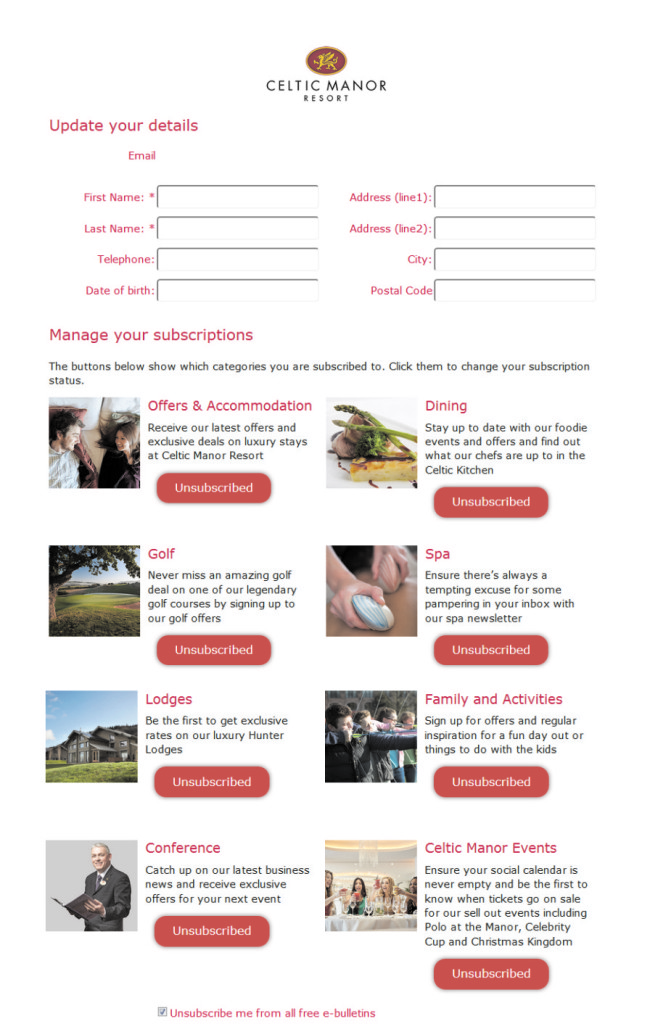Whenever people ask me if they should create preference centres I don’t say, “Yes, do it,” or “No, don’t bother.” Instead, I ask them, “How hard do you want to work?” The usual response is “Huh? How hard could it be? It’s just one page!”
A preference centre is only as important to your customers as you make it. Filling out preferences isn’t the last step. It’s only the beginning.
First Challenge: Develop Your Strategy
Initially, you ask customers to give you their preferences. Then, you have to persuade them to update their data again and again.
You need a strategy that covers the practical aspects of running a preference centre – one that’s useful for your customers as well as your email intentions.
This phase of your preference centre development is the most important but also the hardest. It’s also why many preference centres don’t work. People go straight for the tactics – thinking up questions and formatting the page – but have no fundamental plan behind it.
Your strategy should incorporate these 10 components:
|
That’s a pretty long list and it can make for a long strategic development process. But you need this kind of detailed thinking to create a preference centre that provides value for everybody.
In fact, your strategy for creating a preference centre should be longer than the actual development stage – maybe a year of white-boarding and discussion. But, the more you think it out ahead of time, the more useful your preference centre will be.
In the past, preference centres used to be generally considered an essential part of an email marketer’s arsenal when collecting information about the consumer. However, now with the propagation and accessibility of third party data and insights, companies are comparing preference centres with purchasing external data about their consumers (-which is often more robust, insightful and accurate). This stems from the costs involved with building, maintaining and using the data collected in a preference centre. That said, a strong argument can still be made for companies to have a preference centre if they won’t go down a path of third party data use. Both strategies will drive success as long as they use the data intelligently.

Example of a preference centre
Next Challenge: Using the Data
So, you’ve got some of your customers to give you preference data, what are you going to do with it? (Be realistic. You won’t get everybody to hand over data, either because they don’t like filling out forms, they don’t trust you to keep their data safe, or they just ignore your requests).
Those who do take the time to tell you about themselves, what they like and what they don’t want, will now expect to see those preferences reflected in the messages you send. For example, suppose you ask me my waist size. If I tell you I’m a 38 and you then send me offers for skinny jeans that only go up to a size 28, I’m going to be angry, or, I’ll ignore you. Either way, I’m not going to buy anything, and now you’ve made me mad because I took the time to give you my data and I expect you to remember it.
Another problem with preference centres is decaying data. Sure, you get lots of data you can use for segmentation, triggered messaging, analytics and building demographic profiles or buyer personas, but that information has an expiration date.
Preferences change as the customer’s life changes. They can go stale after just three to four months. That’s why your preference-centre strategy must include a plan for updating the data as well as collecting it.
Final Challenge: Validating and Cross-Referencing Preferences
A preference centre shows you only part of the picture. Your customers might tell you they prefer golf over tennis or have daughters instead of sons, but their buying behaviour shows them checking out tennis racquets and buying boys’ clothing. Are they lying? No, they’re probably shopping for gifts.
Suppose you see behavioural data that implies gift-buying, such as sending items to a different address, or heavy shopping near traditional gift-giving holidays like Valentine’s Day or Christmas. Or, your checkout form includes a box shoppers can tick if the purchase is a gift. Then, use this to create a segment of customers who buy certain products as gifts rather than for personal use. These people don’t need a steady stream of messaging for a one-time purchase. But, they might value gift suggestions triggered at the product purchase anniversary.
Now you see why I said creating a preference centre would be hard work. But, if you take the time to come up with a workable strategy and not just copy what somebody else did, you’ll create a preference centre that gives your customers more control and generates useful data you can convert into relevant messages.





